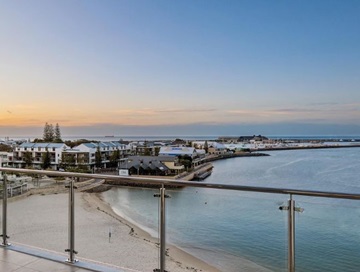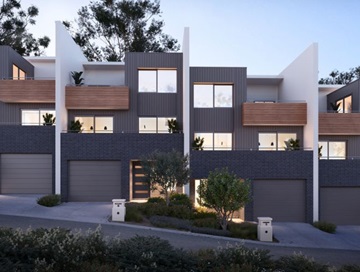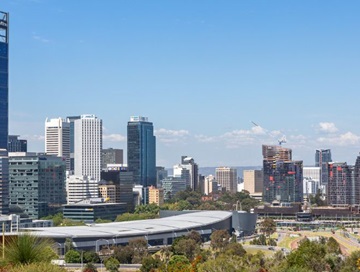Rental supply a nationwide issue in the March 2023 quarter: REIA
28 June 2023"Conditions remained extremely competitive for tenants across the nation in the March 2023 quarter with vacancy rates remaining at low levels, according to the latest REIA Real Estate Market Facts."
.tmb-newsdetail.jpg?sfvrsn=8289ffcd_1)
Conditions remained extremely competitive for tenants across the nation in the March 2023 quarter with vacancy rates remaining at low levels, according to the latest REIA Real Estate Market Facts.
Vacancy rates decreased in Sydney (1.4 per cent), Melbourne (2.3 per cent), Brisbane (0.8 per cent), and Darwin (2.1 per cent). They increased marginally in Perth (0.7 per cent), Canberra (1.7 per cent) and Hobart (1.3 per cent).
Adelaide recorded the lowest vacancy rate at 0.5 per cent.
REIWA CEO Cath Hart said strong demand and declining supply was keeping Perth’s vacancy rate at near-record levels and this was unlikely to change in the short term.
“Longer term there will be some relief for tenants,” she said.
“As building completions increase there will be an increase in new investment supply and this will also free up more homes in the existing rental market as tenants move into their long-awaited new homes.
“Another positive sign is the strong interest our members are reporting from Eastern States buyers. Our relatively affordable housing and high rental yields are encouraging a lot of east coast investment.
“Interestingly, some developers are also noting that Eastern States investors are buying blocks of land, however if they plan to build this will take some time to flow through to the rental market.”
Median rental prices
Perth’s median weekly rent rose 5.1 per cent to $520 for three-bedroom houses and 10 per cent for two-bedroom other dwellings.
Perth recorded the second highest percentage increase for both houses and other dwellings across the country. Despite the increase, it remains among the most affordable capital cities based on rent payments as a percentage of income.
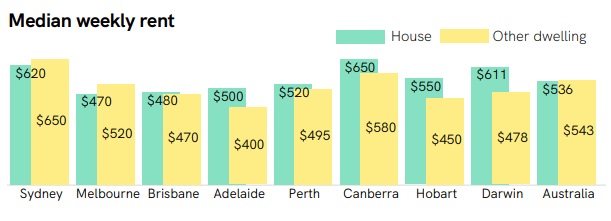
Median house rent prices: Perth and regional centres
Over the quarter, the median rent for houses increased in Perth Middle (5.5 per cent) and Perth Outer (6.0 per cent) and remained stable in Perth Inner.
In regional centres, it increased in Bunbury (5.1 per cent), Broome (3.3 per cent) and Albany (15.4 per cent).
Over the past year, the median rent for houses increased in all metropolitan areas. Perth Inner rose 7.7 per cent, Perth Middle increased 16 per cent and Perth Outer was up by 15.2 percent.
It also increased in all regional areas, with Bunbury up 14.4 per cent, Broome rising 28.3 per cent and Albany increasing 12.5 per cent.
Under current market conditions, more increased are expected.
Median two-bedroom dwelling rent prices: Perth and regional centres
Over the quarter, the median rent for two-bedroom other dwellings increased in all metropolitan areas. Perth Inner rose 6.0 per cent, Perth Middle was up by 6.7 per cent and Perth Outer lifted 2.4 per cent.
Regionally, it decreased in Bunbury (-14.6 per cent), Broome (-18.5 per cent) and Albany (-11.8 per cent).
Annually, all metropolitan areas recorded an increase in the median rent. Perth Inner increased 17.8 per cent, Perth Middle was up 14.3 per cent and Perth Outer rose 10.5 per cent.
In regional WA, it increased in Broome (29.4 per cent) and Albany (2.9 per cent) but decreased in Bunbury (-6.7 per cent).
Median sale prices
According to the REIA data, Perth’s median price for three-bedroom houses was $550,000 in the March 2023, a decline of 1.1 per cent from the December 2022 quarter, but an increase of 2 per cent over the year.
The median price for other dwellings remained stable at $395,000 but decreased 4.8 per cent annually.
Ms Hart said the Perth property market had been remarkably resilient in the face of interest rate rises.
“WA is experiencing strong population growth, which is underpinning demand,” she said.
“The challenging rental market and increasing costs and delays in the building industry are also seeing more people decide to buy rather than rent or build.”
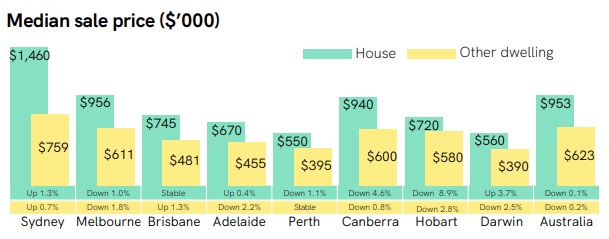
Darwin (3.7 per cent) recorded the highest median house price growth over the quarter, followed by Sydney (1.3 per cent). Hobart recorded the greatest decline (-8.9 per cent).
Brisbane (1.3 per cent) saw the most growth in the median price for other dwellings. Hobart (-2.8 per cent) again had the largest decrease.
Perth was the most affordable capital city by median house price and the second most affordable by median price for other dwellings.
Median house sale prices: Perth and regional centres
Over the quarter, the median house price increased in Perth Outer (1.2 per cent) but decreased in both Perth Inner (-7.7 per cent) and Perth Middle (-3.8 per cent).
Regionally, it increased in Bunbury (1.4 per cent) but decreased in Broome (-6.5 per cent) and Albany (-0.3 per cent).
Over the past year, the median house price increased in Perth Outer (5.4 per cent) but decreased in Perth Inner (-11.2 per cent) and Perth Middle (-1.1 per cent).
Annually, Bunbury (3.5 per cent) and Albany (8.5 per cent) recorded an increase, while Broome (-2.6 per cent) saw a decline.
Median two-bedroom dwelling sale prices: Perth and regional centres
Over the quarter, the median price for other dwellings increased in Perth Outer (1.6 per cent) but declined in Perth Inner (-1.5 per cent) and Perth Middle (-2.3 per cent).
Regionally Bunbury (1.6 per cent), Broome (3.4 per cent) and Albany (21.2 per cent) all recorded increases in their median price for other dwellings over the quarter.
Annually, the median price for other dwellings decreased in all metropolitan areas. Perth Inner was down 4.1 per cent, Perth Middle declined 5.4 per cent and Perth Outer decreased 0.7 per cent.
In the regions, Bunbury (2.4 per cent) and Albany (40.5 per cent) recorded an annual increase, while Broome (-4.9 per cent) saw the median price for other dwellings decline.
10.tmb-rcarousel.jpg?sfvrsn=27391bc0_1)

